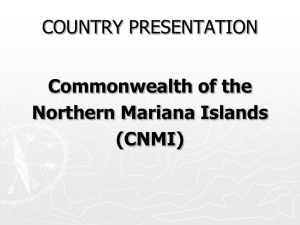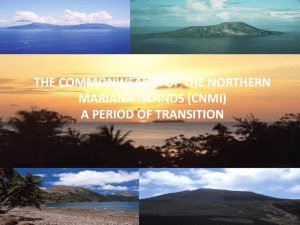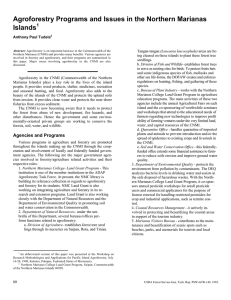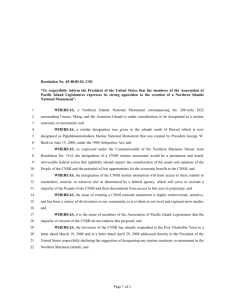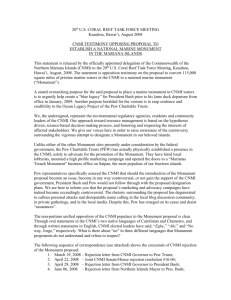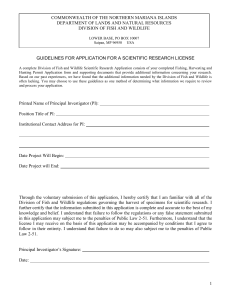DRADDDDfddr February 16, 2010 The Honorable Jeff Bingaman
advertisement
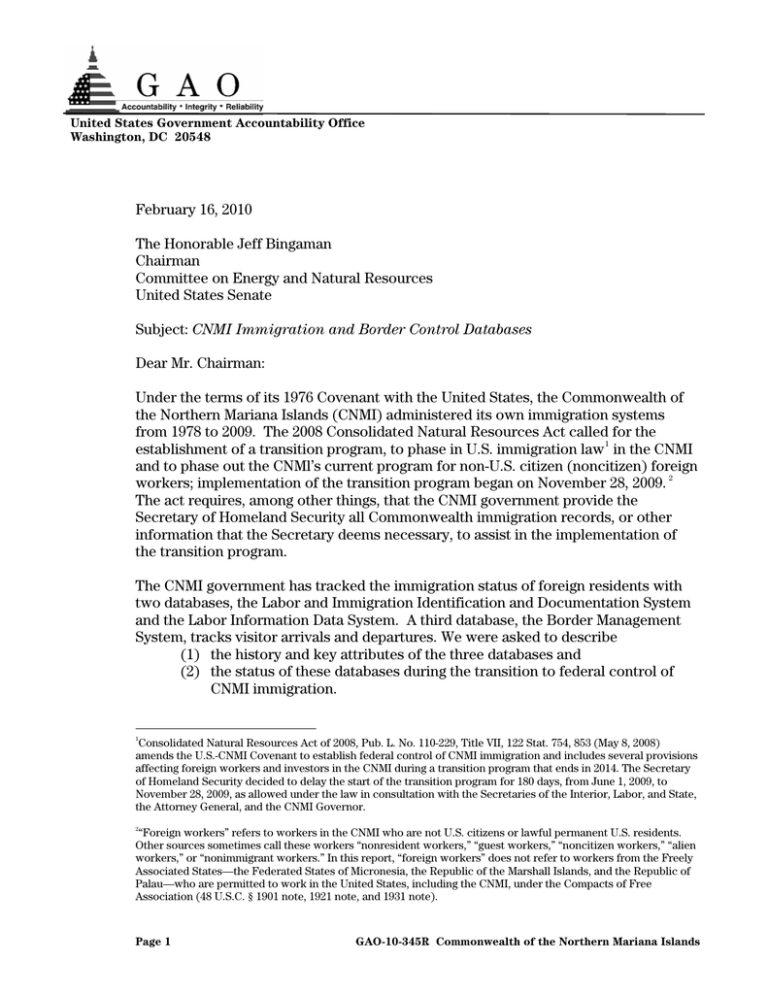
DRADDDDfddr United States Government Accountability Office Washington, DC 20548 February 16, 2010 The Honorable Jeff Bingaman Chairman Committee on Energy and Natural Resources United States Senate Subject: CNMI Immigration and Border Control Databases Dear Mr. Chairman: Under the terms of its 1976 Covenant with the United States, the Commonwealth of the Northern Mariana Islands (CNMI) administered its own immigration systems from 1978 to 2009. The 2008 Consolidated Natural Resources Act called for the 1 establishment of a transition program, to phase in U.S. immigration law in the CNMI and to phase out the CNMl’s current program for non-U.S. citizen (noncitizen) foreign workers; implementation of the transition program began on November 28, 2009. 2 The act requires, among other things, that the CNMI government provide the Secretary of Homeland Security all Commonwealth immigration records, or other information that the Secretary deems necessary, to assist in the implementation of the transition program. The CNMI government has tracked the immigration status of foreign residents with two databases, the Labor and Immigration Identification and Documentation System and the Labor Information Data System. A third database, the Border Management System, tracks visitor arrivals and departures. We were asked to describe (1) the history and key attributes of the three databases and (2) the status of these databases during the transition to federal control of CNMI immigration. 1 Consolidated Natural Resources Act of 2008, Pub. L. No. 110-229, Title VII, 122 Stat. 754, 853 (May 8, 2008) amends the U.S.-CNMI Covenant to establish federal control of CNMI immigration and includes several provisions affecting foreign workers and investors in the CNMI during a transition program that ends in 2014. The Secretary of Homeland Security decided to delay the start of the transition program for 180 days, from June 1, 2009, to November 28, 2009, as allowed under the law in consultation with the Secretaries of the Interior, Labor, and State, the Attorney General, and the CNMI Governor. 2 “Foreign workers” refers to workers in the CNMI who are not U.S. citizens or lawful permanent U.S. residents. Other sources sometimes call these workers “nonresident workers,” “guest workers,” “noncitizen workers,” “alien workers,” or “nonimmigrant workers.” In this report, “foreign workers” does not refer to workers from the Freely Associated States—the Federated States of Micronesia, the Republic of the Marshall Islands, and the Republic of Palau—who are permitted to work in the United States, including the CNMI, under the Compacts of Free Association (48 U.S.C. § 1901 note, 1921 note, and 1931 note). Page 1 GAO-10-345R Commonwealth of the Northern Mariana Islands To address these objectives, we incorporated information from our prior work 3 and 4 continuing work and reviewed relevant documents from the CNMI government and from the U.S. Departments of Homeland Security (DHS) and the Interior (DOI). History and Key Attributes of CNMI Immigration and Border Control Databases Labor and Immigration Identification and Documentation System The CNMI developed the Labor and Immigration Identification and Documentation System (LIIDS) as an administrative data system to track information on individuals who entered the CNMI for employment and other purposes. 5 In 1995, DOI provided a $1.5 million grant to the CNMI to establish an immigration and labor identification and documentation system. In 2000, the CNMI government provided an additional $377,221 to enhance the LIIDS system to include tracking of all individuals entering and exiting the Commonwealth. In 2004, DOI approved another grant for $355,000 to upgrade the LIIDS system software and to purchase hardware. LIIDS contained biographical, employment, and arrival and scheduled departure data on all foreign workers in the CNMI. It also contained information from applications, processing actions, employer reports, temporary work authorizations, labor cases, agency cases, and court cases. Following are some of LIIDS’s key data input elements (see encl. I for a list of specific LIIDS data input elements and definitions): • personal information on workers (photograph, name, date of birth, citizenship, gender, permanent address, and immigration classification); • information about employers (name, industry, and phone number); • information about the jobs to be performed by workers for employers (job description or occupation, wage type and amount, and address or location); • bond arrangements (company, number, and expiration date); • fees paid (amount and receipt number); and • action taken on the applications. 3 Prior related GAO reports include Commonwealth of the Northern Mariana Islands: Managing Potential Economic Impact of Applying U.S. Immigration Law Requires Coordinated Federal Decisions and Additional Data, GAO-08-791 (Washington, D.C.: Aug. 4, 2008); Commonwealth of the Northern Mariana Islands: Pending Legislation Would Apply U.S. Immigration Law to the CNMI with a Transition Period, GAO-08-466 (Washington, D.C.: Mar. 28, 2008); and Northern Mariana Islands: Procedures for Processing Aliens and Merchandise, GAO/GGD-00-97 (Washington, D.C.: May 26, 2000). 4 The American Recovery and Reinvestment Act of 2009 (Pub. L. No. 111-5, Div.A, Title VIII, 123 Stat. 115, 186) requires that GAO report annually on the impact of the minimum wage increases in American Samoa and the CNMI, in 2010 and each year thereafter until the minimum wages reach the U.S. minimum wage. The Consolidated Natural Resources Act of 2008 (Pub. L. No. 110-229, Title VII, 122 Stat. 754, 865) requires that GAO report on implementation and economic impact of legislation that extends U.S. immigration laws to the CNMI, no later than 2 years after enactment of the act. 5 LIIDS also contained information on students, foreign investors, and relatives of foreign workers. Page 2 GAO-10-345R Commonwealth of the Northern Mariana Islands LIIDS generated the following outputs: • entry permit cards for individual workers that contain the worker’s photo, basic information, island, employer, occupation category, immigration classification and application status, date printed, and expiration date of the permit; • transmittal reports indicating status of applications in the system; • reports on individual workers for labor cases or law enforcement background checks for individuals detained or arrested; • reports on all workers employed by a single employer; • standard statistical reports, such as reports on applications submitted and permits issued; and • audit reports on system use. Labor Information Data System In 2007, the CNMI government revised its foreign worker program and the CNMI Department of Labor undertook an automation project to replace LIIDS with the 6 Labor Information Data System (LIDS). According to the CNMI’s Department of Labor, the Governor funded the acquisition of the new system. On February 1, 2008, LIDS was brought online, and by July 2008, the system was further revised based on staff suggestions. In 2009, two new modules were added to the system, covering administrative hearings and enforcement, and the system’s main module for labor processing was further updated. Officials from CNMI’s Department of Labor also adapted the software to process and issue 19,404 umbrella permits in 2009. 7 According to a representative of the department, LIDS differs from LIIDS primarily in the way that information is gathered: LIDS uses scanners to upload information from forms, while LIIDS required manual input of information. The CNMI Department of Labor’s 2009 Annual Report to the Legislature noted that some LIDS data on the number of permits issued per year may be greater than the actual number of workers present in the Commonwealth, because all administrative operations are counted as “permit actions” and two or more actions may affect a single worker. For example, if a worker’s contract is amended and employment is extended, two permit actions will be counted in the system. All cancelled permits are also counted as permit actions. Border Management System In 2001, the CNMI government purchased and implemented the Border Management System (BMS), an automated arrivals and departures database containing data from passports, visas, alerts, and permissions (extensions of stay, changes of status, or 6 In 2007, an attorney speaking on behalf of the CNMI’s Secretary of Labor told us that the CNMI government was in the process of upgrading LIIDS. 7 The CNMI Department of Labor issued umbrella permits to all eligible foreign workers, students, investors, and relatives to provide them with status to remain in the Commonwealth after the federalization transition date, November 28, 2009, for a maximum of 2 years. Page 3 GAO-10-345R Commonwealth of the Northern Mariana Islands other modifications of entry conditions) as applicable for all persons entering the CNMI. BMS data is collected primarily through passport readers when persons enter or exit the CNMI at the Commonwealth’s airports and seaports. The passport readers, in conjunction with the BMS Alert Module, use biometric facial recognition to match passport photos with photo alerts. BMS contains the following key data input elements (see encl. II for a list of specific BMS data input elements and definitions): • arrival and departure dates of all individuals transiting the CNMI; • individuals authorized to extend their stay in the CNMI; and • CNMI and INTERPOL notices, compiled in an “alert list.” BMS outputs consist of individual status reports and “overstay” reports of individuals who remain in the CNMI longer than authorized. According to the CNMI’s Department of Labor, the BMS system has since been upgraded. In 2007, the CNMI computer specialist we interviewed noted that some BMS data on arrivals and departures may have been incomplete because the system did not capture information prior to 2001. As a result, statistics on the duration of visits to the CNMI, based on BMS data, may likewise be incomplete. See enclosure III for more detailed information about the history of LIIDS, LIDS, and BMS. Status of CNMI Immigration and Border Control Databases during Transition to Federal Control The LIDS and BMS databases have remained in the CNMI’s control during the CNMI’s transition to U.S. immigration law, and as of January 2010, the U.S. government’s direct access to information in these databases had not yet been established. On July 1, 2008, a senior DHS official sent a letter to the Governor of the CNMI requesting a broad range of documents that included information on the current CNMI system for recording and documenting the entry, exit, work authorization, and authorized conditions of individuals staying in the CNMl. DHS also requested any repositories of fingerprints, photographs, or other biometric information included in the system. On August 19, 2008, the office of the Governor of the CNMI responded to the letter by providing an overview of the BMS system, describing the security of the system, the data input and output, and the immigration system’s history in the Commonwealth. The document notes that BMS collects photographs through passport readers but states that the CNMI does not maintain any repositories of fingerprints or other biometric information to share with DHS. Page 4 GAO-10-345R Commonwealth of the Northern Mariana Islands On September 15, 2009, the CNMI government issued a draft protocol for implementing U.S. immigration law that, among other things, proposes to allow the U.S. government restricted access to information contained in LIDS and BMS, for a fee and in exchange for comparable information. 8 Specifically, the CNMI protocol envisions the following: • DHS and the CNMI will engage in a two-way data exchange, with DHS providing flight entry data and the CNMI providing information from its immigration records (LIDS and BMS). • The CNMI will provide access to CNMI immigration records that DHS formally requests via an appropriate document and within a reasonable time frame. • The CNMI will consider privacy protections in making information available to the U.S. government. • The CNMI expects to recover the cost of generating and producing any information requested by DHS. As of January 2010, the U.S. government had no direct access to LIDS and BMS and had no arrangements in place to obtain direct access, according to U.S. officials. 9 The CNMI government has provided DHS access to the information stored in LIDS and BMS on a case-by-case basis. CNMI has assigned one point of contact to respond to all DHS data inquiries, such as inquiries for verification of an individual’s immigration status. Since the United States assumed control of immigration and border security in the CNMI on November 28, 2009, the CNMI government has continued to maintain and update LIDS and BMS. CNMI Customs officers now collect information to update BMS with data on entries and departures from Commonwealth airports and seaports. Computers and passport readers, previously used by CNMI immigration, have been installed at airport customs inspection stations, and data from customs declaration forms are used to update the system. CNMI Customs officers also update BMS by gathering information from travelers during departure checks that take place prior to TSA security screening. Agency Comments In accordance with GAO protocols, we notified DHS, DOI, and the CNMI government of this study prior to its initiation. We also provided a draft of this report to officials in DHS, DOI, and the CNMI government for review and technical comment. We received technical comments from DHS’ Immigration and Customs Enforcement (ICE) and U.S. Citizenship and Immigration Services (USCIS) and from the CNMI’s Department of Labor, which we incorporated as appropriate. 8 Commonwealth of the Northern Mariana Islands, “The Commonwealth’s Protocol for Implementing P.L. 110-229,” Sept. 15, 2009. The protocol was posted as a public service notice on the CNMI Department of Labor Web site (www.marianaslabor.net/pubntc.asp). 9 According to several Federal Bureau of Investigation (FBI) agents and a previous CNMI Attorney General, from 2005 to 2007, a liaison from the CNMI Department of Labor worked within the FBI’s Saipan office with direct access to LIIDS and BMS to assist the FBI with all ongoing investigations. In 2007, the liaison was released and no replacement was assigned. In order to access the databases, FBI agents must rely on the same CNMI individual as the rest of the U.S. government. Page 5 GAO-10-345R Commonwealth of the Northern Mariana Islands ICE stated in its technical comments that relying on one CNMI point of contact to verify immigration status for individuals subject to department investigations is insufficient and could compromise security for ongoing operations. ICE noted that because DHS operates 24 hours per day, 7 days per week, the CNMI point of contact cannot be responsive to all of the department’s needs. ICE officials said that it is imperative for the department to have direct access to the CNMI data systems in order to perform the department’s mission with maximum efficiency. USCIS suggested in its technical comments that pertinent CNMI immigration information should be integrated into their existing systems: the Computer Linked Application Information Management System (CLAIMS 3 and 4) 10 and the U.S. Visitor and Immigrant Status Indicator Technology (US-VISIT). 11 In the interim, LIDS and BMS databases should be installed as stand-alone systems in Honolulu, Guam, and Saipan for USCIS adjudications access. Staff from USCIS’s California Service Center should also have access to, and be trained in the use of, LIDS and BMS. The CNMI Department of Labor stated in its technical comments that in 2007 it 12 retired LIIDS and replaced it with LIDS. The CNMI Department of Labor referred us to their 2008 Annual Report for more information on LIDS. We modified our report to incorporate this additional information. The CNMI Department of Labor said in its technical comments that the Commonwealth maintains exit data in BMS because DHS does not have a digital exit control system that can provide immediate information regarding visitors who have departed from the Commonwealth. CBP officials confirmed that they conduct exit control only for flights to Guam. CNMI officials also reported that they quickly supply information on individual cases to U.S. officials. A senior CNMI official stated that the Commonwealth’s point of contact is currently meeting all of DHS’s requests. CNMI officials also stated that if the point of contact is unable to respond to future DHS inquiries in a timely manner, CNMI officials would be willing to engage in additional discussions regarding more direct access to LIDS and BMS. Scope and Methodology We relied on information gathered for several prior GAO reviews of CNMI immigration that included analyses of LIIDS and BMS data provided by the CNMI 13 government. In addition, we reviewed formal letters between DHS and the CNMI government, the CNMI protocol for implementing U.S. immigration law, and the CNMI Department of Labor’s 2008 and 2009 Annual Report to the Legislature. Finally, 10 CLAIMS 3 and 4 provides automated support to process and track applications and/or petitions for individuals who have filed and/or paid fees for benefits under the Immigration and Nationality Act, as amended. 11 U.S.-VISIT is designed to collect, maintain, and share data on selected foreign nationals entering and exiting the United States at air, sea, and land ports of entry. 12 13 The LIIDS database was archived and does not contain any current information. GAO-08-791, GAO-08-466, GAO/GGD-00-97. Page 6 GAO-10-345R Commonwealth of the Northern Mariana Islands in January 2010, we verified some of the ICE, USCIS, and the CNMI’s technical comments by meeting with U.S. and CNMI officials in Saipan and Rota. We conducted our work from December 2009 through February 2010, in accordance with all sections of GAO’s Quality Assurance Framework that are relevant to our objectives. The framework requires that we plan and perform the engagement to obtain sufficient and appropriate evidence to meet our stated objectives and to discuss any limitations in our work. We believe that the information obtained, and the analysis conducted during prior GAO reviews of immigration in the CNMI, provide a reasonable basis for our findings. ________________ We are sending copies of this report to Senator Bingaman and interested congressional committees. In addition, the report will be available at no charge on GAO’s Web site at http://www.gao.gov. If you or your staff have any questions, please contact me on (202) 512-3149 or gootnickd@gao.gov. For a list of GAO staff who made major contributions to this report, please see enclosure IV. Sincerely yours, David Gootnick Director, International Affairs and Trade Enclosures - 4 Page 7 GAO-10-345R Commonwealth of the Northern Mariana Islands Enclosure I LIIDS Data Input Elements Until 2007, LIIDS data input elements included information on basic identification, employers’ background, and labor records for each foreign worker. The system also included a photograph of each individual and tracked deficiencies and denials of applications. According to the CNMI’s Department of Labor, in 2007, the Governor funded a complete replacement of LIIDS. The Labor Information Data System (LIDS), the new system, uses different software and powers an automated system. According to CNMI officials, the data input elements listed below may not be the same as those included in LIDS. We requested data input elements and definitions for LIDS. However, the Department of Labor was not able to provide this information because of insufficient staff resources. Table 1 presents a list of specific data input elements and definitions drawn from the LIIDS data collection manual. Table 1: LIIDS Data Input Elements and Definitions Basic identification LIIDS no. The identifying number provided to the person with authorization for entry. Names First, middle, and last name of the person being identified. DOB The date of birth of the person being identified. Citizenship The nationality shown on the passport of the person being identified. Only nationals from certain countries enter the Commonwealth for employment. These are identified in a drop-down menu. Gender The gender of the person being identified. Permanent address The address of the foreign national worker in his or her country of citizenship. Employer background Employer The name of the employer as shown on the employer’s CNMI business license. DBA Any other name entered by the employer as “doing business as”. Phone Employer’s primary phone contact. Emp. prefix The standard industry classification in which the employer’s business falls. Barred Whether the employer is barred from using foreign workers. Date barred The date of the order from the Hearing Officer. Comments Notes with respect to the order barring this employer. A bar may be indefinite, permanent, or for a defined period of time. The comment also typically identifies the case number and administrative order in which the bar was entered. Labor record Entry date The date on which Labor Processing officer put information into the system about the application. Application date The date on which the application was received by Labor Processing. Application status The application for employment is a new application, a renewal, an amendment, a consensual transfer, or an expiration transfer. Receipt The number of the receipt that was issued when a fee was paid. a A standard list of industry categories, same as the “employer prefix”. Industry a The name of the employer that submitted the application. Employer Occupation The job classification within which the employee is entitled to work while in the Commonwealth. Page 8 GAO-10-345R Commonwealth of the Northern Mariana Islands Fee Comment Tel. no. Local address Entry date Wage type Wage rate Bond co. Bond no. Bond exp Replacing LIA no. Exempt and CAP Comments Island Class Approval date Exp. date Comments The amount of the fee that was paid. Notes or comments by Labor Processing personnel. The local contact number for the foreign worker. The local address for service of process and notices. The date on which the wage and bonding information is entered. The way wages are paid: hourly, bi-weekly, monthly, quarterly, semi-annually, annually, salary. The rate paid for an hourly employee and the hourly equivalent paid other employees. The bonding company holding the bond securing employer obligations for this employee. The bond number issued with respect to this employee. The expiration date of the bond. Indication of whether the employee is subject to the moratorium and is a replacement for another foreign worker in the same job classification. The limited immunity program number, which is no longer used. Categories used for moratorium purposes. Information with respect to wages, bonding, or moratorium status. The place where the employee will be working: Saipan, Rota, or Tinian. The immigration classification of the worker. The date of approval of the most recent permission. The expiration date of the most recent permission. Space for notes about island or class. Source: Commonwealth of the Northern Mariana Islands, Data Collection Manual: Labor Identification and Documentation System, 2007. Note: According to a CNMI computer specialist whom we interviewed in 2007, 14 some data on employment duration may be incomplete because LIIDS did not capture data on foreign workers’ employment prior to 1995. As a result, statistics on foreign workers’ full employment history in the CNMI, based on LIIDS data, may likewise be incomplete. According to CNMI officials, employment data exist as far back as 1985 but software vendors no longer support its digital format. a Some data reported by employers were inconsistent because LIIDS lacked standardized data inputs for “industry” and “occupation” categories. As of October 2007, such standardized categories had not yet been established. However, CNMI officials noted that over the past 2 years, the following standard codes have been implemented: the North American Industry Classification System, which identifies an employer’s industry, and the Occupational Information Network, a system for classifying jobs. 14 We conducted this interview in conjunction with our work in preparing GAO-08-791. Page 9 GAO-10-345R Commonwealth of the Northern Mariana Islands Enclosure II BMS Data Input Elements BMS data input elements include information on basic identification, movement (arrivals and departures), imagery (full image of passport), and entry permission. According to the CNMI’s Department of Labor, the BMS system has been upgraded since we obtained these data input elements. Table 2 presents a list of some specific data input elements and definitions drawn from the BMS data collection manual. Table 2: BMS Data Input Elements and Definitions Basic identification Document country The name of the country that issued the passport. Document type Usually a passport; occasionally some other travel document. Document number The passport number. Surname The last name of the passport holder. Given names The first and middle names of the passport holder. Nationality The citizenship of the passport holder. Birth date The passport holder’s birth date. Personal ID Some governments, such as China, have a national identity card system; this field captures that information. This is not a required field, and it does not contain U.S. social security numbers. Sex Male or female as declared by the passport holder. Birth place The birthplace of the passport holder. Document issued The date the passport was issued. Document expires The date the passport expires. SystemID The number that uniquely identifies a record in each table. It is sequentially allocated automatically by BMS and usually is not visible to the user. It is used by the system administrator. Link from Passport number used when the passport holder previously entered the Commonwealth under a different passport (which has expired, been lost and replaced, or indicates a new name due to marriage/divorce/name change). Movement Direction Arrival or departure. Default is arrival. Movement date The date on which the person appeared before an immigration officer. Border port The place where the person appeared before an immigration officer. Entry permit type A list of entry permits within the CNMI system. Purpose A list of entry objectives which include business, tourism, employment, official, diplomatic, crew, military, transit, education, relative, religious, migration, and alien retiree. Stay number A number that indicates how long the person entering the Commonwealth will be allowed to stay. It is prefilled for certain categories of visitors (for example, tourists are allowed 30 days). Stay unit The unit that matches the stay number: days, weeks, months, quarters, years. Stay until The date on which the entry permission expires. For example, although tourists are generally allowed 30-day stays unless extended, charter flights from China carry specific exit dates at the end of the tour that usually do not include the full 30 days. Reference A note field in which the immigration officer may identify the person whom the entering person will visit or with whom he or she will work. Flight/vessel The airline and flight number. Permit number Tourists coming to the CNMI from some countries have a visa number that is entered here. Foreign workers coming to the CNMI enter with an Authorization For Entry (AFE) document that carries an identifying number that is entered here. This Page 10 GAO-10-345R Commonwealth of the Northern Mariana Islands Hotel/stay where IdentityID UserID Change date Imagery Type IdentityID UserID Change date Entry permission Permission type Granted date Stay until LIIDS number Receipt number SystemID, IdentityID, UserID is the same as the LIIDS number that will be on the Entry Permit card issued to the worker after the health certification is obtained. The location where the entrant will stay. This is generally collected for statistical information for the visitor program. A system generated number unique to the individual who is being identified by this record. The user ID of the Immigration Officer who is making or verifying the entry data from the BorderGuard passport reader. The date that information on this screen is updated/changed. The type of document that has been imaged—usually a passport A system-generated number unique to the person being identified. The user ID of the Immigration Officer that processed the passport at arrival or departure. The date on which the passport was scanned. The person’s current immigration status. It is the same as the entry permit type. The date on which the new permission was granted by an immigration officer. This defaults to the current date. The new date on which the permission will expire. Tourists or business persons may be granted an additional 30 or 60 days. Foreign workers will be granted one year upon renewal or transfer, and they must register a new permission every year. The identifying number on their permit for foreign workers who have entry permits. The receipt number indicating payment of fees for extensions and permissions. The same information as listed on other screens described above. Source: Commonwealth of the Northern Mariana Islands, Data Collection Manual: Border Management System, 2007. Page 11 GAO-10-345R Commonwealth of the Northern Mariana Islands Enclosure III History of LIIDS, LIDS and BMS Development In 1995, the U.S. Department of the Interior (DOI) funded the CNMI government’s development of the Labor and Immigration Identification and Documentation System (LIIDS) with an initial grant of $1.5 million. A prototype database, utilizing Microsoft Access 2.0, became operational in July 1995 with capacity to store a year’s worth of data while a full system was developed. The prototype database collected information about foreign workers (see encl. I). Beginning in May 1996, LIIDS was used to issue a small plastic identification card, known as the entry permit card, to each foreign worker who entered the CNMI. The card recorded the worker’s basic personal data and displayed the worker’s photo but did not contain historical information. In November 1998, LIIDS software was completed, and by January 1999, the database was upgraded to Microsoft Access 97. Added features included additional data security measures, bar codes on entry permit cards, and new fields to record approval dates and legal requirements. Flags were added to the system to show barring of employers, deportation orders against foreign workers, terminations for cause, and similar frequently used information. By May 1999, hardware had been acquired and LIIDS came online with newly acquired, installed, and networked terminals. The new system allowed the database to provide a history of each foreign worker’s employment in the CNMI. From 1999 to 2001, LIIDS was used for both labor and immigration purposes. After 2001, following the CNMI government’s purchase of the Border Management System (BMS), LIIDS was used to track information on individuals who have entered the CNMI for employment and other purposes only. According to the CNMI Department of Labor, the CNMI government purchased BMS from an Australian vendor that supplies several countries with immigration data systems, usually under the auspices of the Australian foreign aid program. Since 2001, BMS has been used to track all persons entering and departing the CNMI, including tourists, foreign workers, and U.S. citizens. Following the federalization of CNMI immigration and border control on November 28, 2009, the CNMI government continued to maintain the BMS system, using CNMI Customs officers to gather information from visitors at the Commonwealth’s ports of entry. In 2004, the CNMI government began to upgrade the LIIDS software as well as some hardware used by the CNMI Department of Labor. The software was designed and completed in 2005, with final testing in 2006. Although the file server and scanner hardware were acquired in 2005, delays in receiving 2007 grant funds from DOI led the CNMI government to postpone procurement of personal computers and network printers until fiscal year 2008. In 2007, the CNMI Department of Labor undertook an automation project to replace the LIIDS software. On February 1, 2008, the Labor Information Data System (LIDS) Page 12 GAO-10-345R Commonwealth of the Northern Mariana Islands was brought online and by July 2008, the system was further revised based on staff suggestions, as described in the CNMI Department of Labor’s 2008 Annual Report. In 2009, two new modules were added to the system, covering administrative hearings and enforcement, and the system’s main module for labor processing was further updated, as described in the CNMI Department of Labor’s 2009 Annual Report. According to CNMI officials, LIDS constitutes a completely different automation system than the original LIIDS and was funded by the Governor in 2007. In 2010, a representative from the CNMI Department of Labor told us that the major difference between the systems is the way information is gathered; LIDS uses scanners to upload information from forms automatically, while LIIDS required manual data input. The CNMI Department of Labor was unable to provide more detailed information due to insufficient staff resources. Page 13 GAO-10-345R Commonwealth of the Northern Mariana Islands Enclosure IV GAO Contact and Staff Acknowledgment GAO Contact David Gootnick (202) 512-3149 or gootnickd@gao.gov Staff Acknowledgments In addition to the person named above, Emil Friberg (Assistant Director), Julia A. Roberts, R. Gifford Howland, Reid Lowe, Ashley Alley, Mona Sehgal, and Ben Bolitzer made key contributions to this report. (320746) Page 14 GAO-10-345R Commonwealth of the Northern Mariana Islands This is a work of the U.S. government and is not subject to copyright protection in the United States. The published product may be reproduced and distributed in its entirety without further permission from GAO. However, because this work may contain copyrighted images or other material, permission from the copyright holder may be necessary if you wish to reproduce this material separately. GAO’s Mission The Government Accountability Office, the audit, evaluation, and investigative arm of Congress, exists to support Congress in meeting its constitutional responsibilities and to help improve the performance and accountability of the federal government for the American people. GAO examines the use of public funds; evaluates federal programs and policies; and provides analyses, recommendations, and other assistance to help Congress make informed oversight, policy, and funding decisions. GAO’s commitment to good government is reflected in its core values of accountability, integrity, and reliability. Obtaining Copies of GAO Reports and Testimony The fastest and easiest way to obtain copies of GAO documents at no cost is through GAO’s Web site (www.gao.gov). Each weekday afternoon, GAO posts on its Web site newly released reports, testimony, and correspondence. To have GAO e-mail you a list of newly posted products, go to www.gao.gov and select “E-mail Updates.” Order by Phone The price of each GAO publication reflects GAO’s actual cost of production and distribution and depends on the number of pages in the publication and whether the publication is printed in color or black and white. Pricing and ordering information is posted on GAO’s Web site, http://www.gao.gov/ordering.htm. Place orders by calling (202) 512-6000, toll free (866) 801-7077, or TDD (202) 512-2537. Orders may be paid for using American Express, Discover Card, MasterCard, Visa, check, or money order. Call for additional information. To Report Fraud, Waste, and Abuse in Federal Programs Contact: Congressional Relations Ralph Dawn, Managing Director, dawnr@gao.gov, (202) 512-4400 U.S. Government Accountability Office, 441 G Street NW, Room 7125 Washington, DC 20548 Public Affairs Chuck Young, Managing Director, youngc1@gao.gov, (202) 512-4800 U.S. Government Accountability Office, 441 G Street NW, Room 7149 Washington, DC 20548 Web site: www.gao.gov/fraudnet/fraudnet.htm E-mail: fraudnet@gao.gov Automated answering system: (800) 424-5454 or (202) 512-7470
